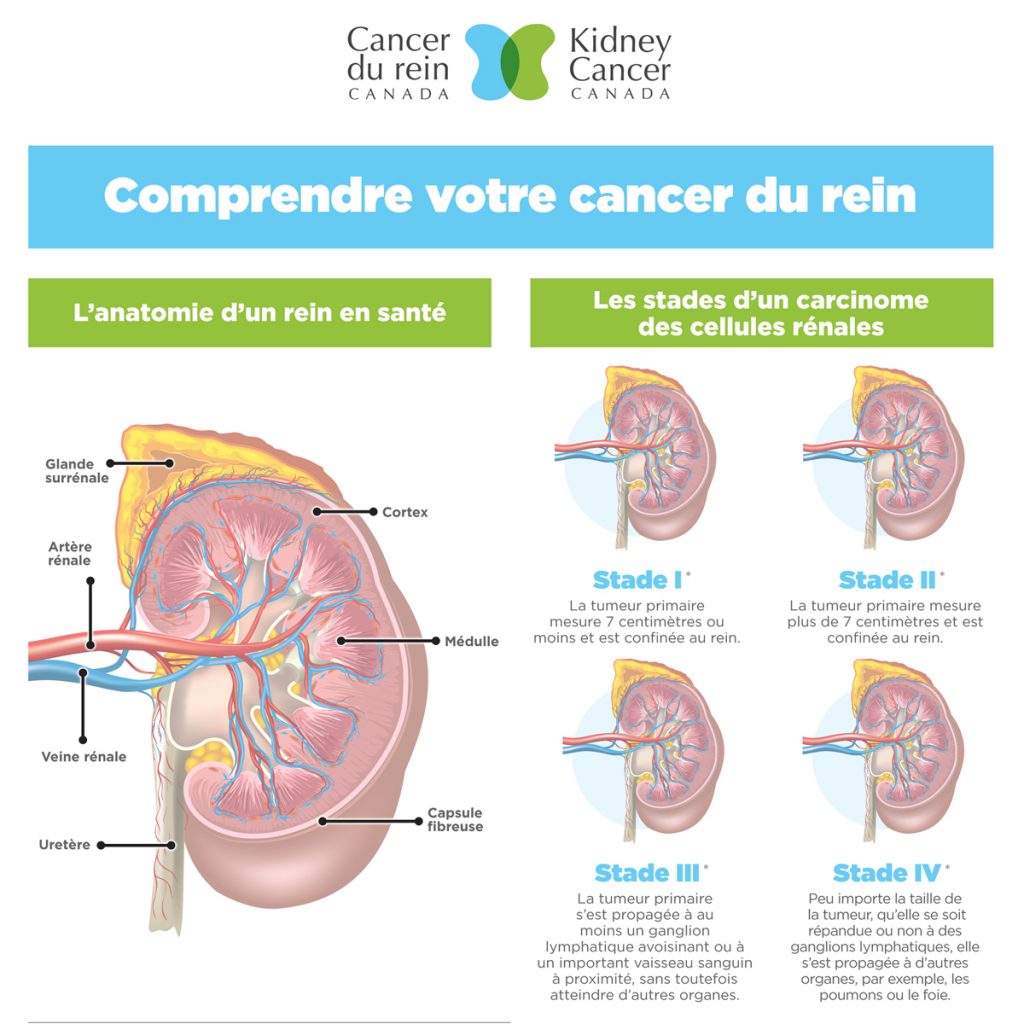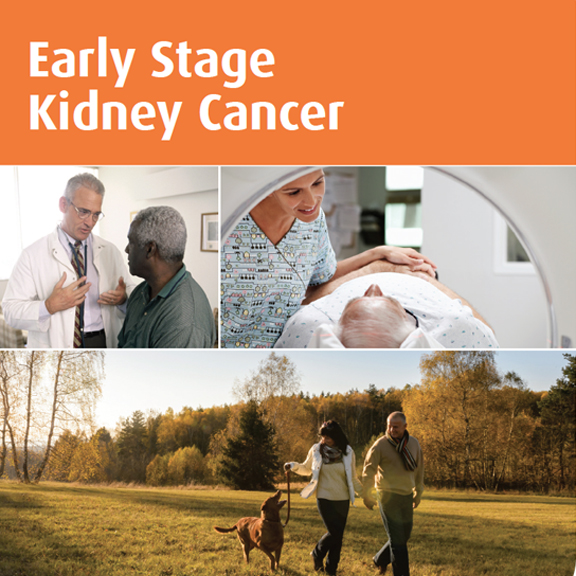Some inherited health conditions or syndromes can increase the risk of developing kidney cancer. These conditions may also be called inherited or hereditary kidney cancer syndromes. Many of these inherited conditions are linked to a particular type of kidney cancer and they can also be associated with other health issues that may need ongoing screening tests or treatments. In general, if either parent has a gene mutation, there is a 50% chance they will pass it on to their children.
People with these inherited conditions often develop kidney cancer at a younger age than usual.
The main inherited disorders that increase a person’s risk of developing kidney cancer are described below:
- Von Hippel-Lindau (VHL) Syndrome
- Tuberous Sclerosis Complex (TSC)
- Birt-Hogg-Dube (BHD) Syndrome
- Hereditary Papillary Renal Cell Carcinoma (HPRC)
- Hereditary Leiomyomatosis and Renal Cell Carcinoma (HLRCC)
- Hereditary Paraganglioma and Pheochromocytoma Syndromes
- BAP-1 Associated Renal Cell Carcionoma
- Cowden Syndrome
VON HIPPEL-LINDAU (VHL) SYNDROME
The most well known inherited kidney cancer syndrome is von Hippel-Lindau (VHL) syndrome. VHL is a rare inherited condition that runs in some families. It is caused by a mutation in a gene called the VHL gene. VHL syndrome can cause fluid-filled sacs (called cysts) or tumours that occur in the eyes, brain, spine, inner ear, lung, liver, pancreas, genital tract, kidney and adrenal gland. The tumours can be benign (not cancer), but some can turn into cancer.
VHL increases the risk of developing kidney cysts and kidney cancer. The most common type of kidney cancer that people with VHL develop is clear cell kidney cancer. Anywhere from 35% to 75% of people with VHL syndrome develop clear cell kidney cancer. People with VHL sometimes have hundreds of tumours within the kidney (multifocal tumours) and the tumours tend to occur in both kidneys (bilateral tumours). The average age that kidney cancer is diagnosed in people with VHL syndrome is about 40 years of age, but screening for kidney cancer in people with VHL starts at a much younger age. Tumours are treated with surgery (partial nephrectomy) or ablative therapy when they become larger than 3 cm.
TUBEROUS SCLEROSIS COMPLEX (TSC)
Tuberous sclerosis complex (TSC) is an inherited genetic condition that causes noncancerous (benign) tumours to grow in many different organs, mainly the brain, kidney, heart, eyes, lung and skin. Even though these tumours are usually not cancerous, they can still cause problems. TSC is caused by mutations in genes called TSC1 and TSC2. TSC can occur because of a mutation in either one of these genes. About one-third of people with TSC inherit it from a parent who also has the condition.
TSC can cause benign fluid filled sacs (cysts) in the kidney or benign tumours in the kidney made up of blood vessels, smooth muscle cells and fat cells called renal angiomyolipomas (AML). These can grow to become quite large and can affect kidney function. Renal angiomyolipomas may also rupture and bleed, which can be very serious. Kidney cysts and angiomyolipomas often start in childhood. Although TSC is associated with an increased risk of kidney cancer, it actually occurs in less than 5% of people with this condition. When someone is diagnosed with TSC, they will be screened to see if they have cysts or angiomyolipomas in the kidney and their kidney function will be checked. Because the TSC genes control cell growth by blocking a protein called mTOR, an mTOR inhibitor drug called everolimus (Afinitor®) may be used to control growing angiomyolipomas in the kidney and decrease the chance of them bleeding in people with TSC.
Birt-Hogg-Dube syndrome (BHD) is a rare inherited condition. It is caused by a mutation in the folliculin (FLCN) gene. People with BHD can develop noncancerous (benign) bumps on the skin, lung cysts, collapsed lungs and kidney cancer. BHD mainly affects adults and symptoms of BHD usually appear in adults in their 20s and 30s.
BHD syndrome can cause fluid filled sacs in the kidney (called cysts) and kidney cancer. Roughly 1 in 3 people with BHD (about 30%) get kidney cancer. People with BHD develop a variety of types of kidney cancer, including chromophobe tumours, oncocytomas or a mixture of both of these. Less often, people with BHD develop clear cell or papillary kidney cancer. People with BHD usually develop tumours in both kidneys (bilateral tumours) or more than one tumour in the same kidney at the same time. In most cases these tumours grow very slowly, often do not spread and are not life-threatening. It is recommended that people with BHD get screened for kidney cancer starting at age 20. Tumours are usually removed once they reach 3 cm.
HEREDITARY PAPILLARY RENAL CELL CARCINOMA (HPRC)
Hereditary papillary renal cell carcinoma (HPRC) is a fairly rare genetic condition. It is caused by a mutation in a gene called the MET gene. HPRC increases the risk of developing type 1 papillary kidney cancer. Unlike the other hereditary kidney cancer syndromes, people with HPRC do not have tumours in other parts of the body, just the kidney.
People with HPRC have an increased risk of developing many kidney tumours in both kidneys (bilateral tumours). HPRC may be suspected when a person has been diagnosed with type 1 papillary kidney cancer and there are other close relatives who have also had the same type of cancer. Initial screening for kidney cancer may be done at age 18 in people with HPRC. If no kidney lesions are noticed at this time, then screening can be done again at age 30, when the risk of kidney cancer is increased. Treatment depends on the size of kidney tumours detected, but generally the tumour is monitored regularly until it reaches 3 cm.
HEREDITARY LEIOMYOMATOSIS AND RENAL CELL CARCINOMA (HLRCC)
Hereditary leiomyomatosis and renal cell carcinoma (HLRCC) may also be called Reed’s syndrome. HLRCC is caused by a mutation in the fumarate hydratase (FH) gene. HLRCC is associated with noncancerous (benign) smooth muscle tumours called leiomyomas, which appear on the skin as bumps or in the uterus as fibroids. A small number of people with HLRCC develop kidney cancer.
HLRCC increases the risk of developing type 2 papillary kidney cancer. Other types of kidney cancer can also develop in people with HLRCC, including collecting duct and clear cell cancer, but these types do not occur nearly as often as type 2 papillary cancer. The average age that people with HLRCC get kidney cancer is around age 40. Screening for kidney cancer in people with HLRCC generally begins around age 18. HLRCC-associated kidney cancer is often aggressive and even small tumours tend to spread (metastasize) early, so it does not act like most of the other hereditary kidney cancer syndromes.
The key to managing HLRCC kidney tumours is regular checkups and testing, so that any tumours are found when they are small. Surgery to remove the tumour, if possible, is the treatment of choice when a kidney tumour is found, regardless of the size because of the aggressive nature of type 2 papillary kidney cancer.
HEREDITARY PARAGANGLIOMA AND PHEOCHROMOCYTOMA SYNDROMES
Pheochromocytomas and paragangliomas are rare tumours that come from a certain type of cells found near nerve cells bunches. Pheochromocytoma (PCC) develops in the adrenal gland, which is a small gland located on top of the kidneys. Pheochromocytoma usually affects only one adrenal gland, but sometimes it can affect both glands. Sometimes there is more than one tumour in an adrenal gland. Paraganglioma (PGL) is a similar type of tumour that forms near the carotid artery in the neck, along nerve pathways in the head and neck and can also develop in other parts of the body. Since they develop outside the adrenal gland, they are referred to as being extra-adrenal. While PCC and PGL are often not cancerous (benign), they can have important effects on a person’s health and surgery is often needed. In some cases these tumours can also become cancerous.
These tumours are caused by mutations in certain genes and they can be inherited. They are caused by mutations in the succinate dehydrogenase (or SDH) family of genes and include SDHA, SDHB, SDHC and SDHD. These genes affect SDH enzyme production, which can cause abnormal cell growth. Hereditary pheochromocytoma and paraganglioma can cause benign or cancerous tumours to form in the adrenal gland or extra-adrenal tissues.
People with hereditary PCC and PGL syndrome also have an increased risk of developing kidney cancer, mainly clear cell kidney cancer. Of the SDH family of genes, SDHB, SDHC and SDHD are most often linked to kidney cancer. When kidney cancer is diagnosed in people with these hereditary syndromes, they are usually in their early 30s, but it can occur in people younger or older than 30. Kidney cancer screening may start as early as age 15 in people with PCC and PGL. People with hereditary PCC or PGL syndrome usually have surgery to remove their tumour, because even small tumours have the potential to spread (metastasize).
BAP-1 ASSOCIATED RENAL CELL CARCINOMA
A mutation in the BRCA1-associated protein-1 (BAP-1) gene, has led to the reporting of a rare new hereditary cancer syndrome. BAP-1 mutations have been linked to an increased risk for certain cancers, especially melanoma of the eye (in the part of the eye called the uvea) and a type of lung cancer called mesothelioma.
People with a BAP-1 gene mutation also have an increased risk of developing kidney cancer, particularly clear cell kidney cancer. It is really not known how common kidney cancer is in people with BAP-1 mutations and there are no specific guidelines for early screening for kidney cancer in people with BAP-1 mutations.
Cowden syndrome is caused by a mutation in a gene called PTEN. Cowden syndrome is an inherited disorder that increases the risk of noncancerous (benign) and cancerous tumours of the breast, thyroid and uterus (endometrium). Cowden syndrome is also called PTEN hamartoma tumour syndrome, because the many benign tumour-like growths that occur are called hamartomas.
Cowden syndrome can also increase the risk of developing kidney cancer. The typical age of onset of kidney cancer in people with Cowden syndrome is around 40 years of age. Screening for kidney cancer in people with Cowden syndrome is recommended starting at age 40.
SECTION REFERENCES:
- Von Hippel-Lindau (VHL) Syndrome
- Haas NB, Nathanson KL. Hereditary renal cancer syndromes. Advances in Chronic Kidney Disease. 2014; Jan; 21(1):81-90.
- Ho TH, Jonasch E. Genetic Kidney Cancer Syndromes. Journal of the National Comprehensive Cancer Network. 2014; September;12(9):1347-1355.
- Lattouf JB, Pautler SE, Reaume MN, Eva ,et al. Structured assessment and followup for patients with hereditary kidney tumour syndromes. Canadian Urological Association Journal. 2016; 10(7-8):E214-22.
- Linehan WM. Genetic basis of kidney cancer: role of genomics for the development of disease-based therapeutics. Genome Research. 2012; Nov;22(11):2089-100.
- National Cancer Institute. Genetics of Kidney Cancer (Renal Cell Cancer) (PDQ®) – Health Professional Version. Updated: 10/13/2016.
- Reaume MN, Graham GE, Tomiak Eva, et al. Canadian guideline on genetic screening for hereditary renal cell cancers. Canadian Urological Association Journal. 2013; 7(9-10):319-323.
- VHL Canada. 2016.
- VHL Alliance. Patients and Caregivers. What is VHL? Last modified: 7/27/2016.
- Tuberous Sclerosis Complex (TSC)
- Haas NB, Nathanson KL. Hereditary renal cancer syndromes. Advances in Chronic Kidney Disease. 2014; Jan; 21(1):81-90.
- Ho TH, Jonasch E. Genetic Kidney Cancer Syndromes. Journal of the National Comprehensive Cancer Network. 2014; September;12(9):1347-1355.
- Lattouf JB, Pautler SE, Reaume MN, Eva ,et al. Structured assessment and followup for patients with hereditary kidney tumour syndromes. Canadian Urological Association Journal. 2016; 10(7-8):E214-22.
- Linehan WM. Genetic basis of kidney cancer: role of genomics for the development of disease-based therapeutics. Genome Research. 2012; Nov;22(11):2089-100.
- National Cancer Institute. Genetics of Kidney Cancer (Renal Cell Cancer) (PDQ®) – Health Professional Version. Updated: 10/13/2016.
- Reaume MN, Graham GE, Tomiak Eva, et al. Canadian guideline on genetic screening for hereditary renal cell cancers. Canadian Urological Association Journal. 2013; 7(9-10):319-323.
- Tuberous Sclerosis Canada / Sclérose Tubéreus. (TSC Canada). 2016.
- Tuberous Sclerosis Alliance. What is TSC? 2016.
- Birt-Hogg-Dube(BHD) Syndrome
- BHD Foundation. For Families. 2016
- Haas NB, Nathanson KL. Hereditary renal cancer syndromes. Advances in Chronic Kidney Disease. 2014; Jan; 21(1):81-90.
- Ho TH, Jonasch E. Genetic Kidney Cancer Syndromes. Journal of the National Comprehensive Cancer Network. 2014; September;12(9):1347-1355.
- Lattouf JB, Pautler SE, Reaume MN, Eva ,et al. Structured assessment and followup for patients with hereditary kidney tumour syndromes. Canadian Urological Association Journal. 2016; 10(7-8):E214-22.
- Linehan WM. Genetic basis of kidney cancer: role of genomics for the development of disease-based therapeutics. Genome Research. 2012; Nov;22(11):2089-100.
- National Cancer Institute. Genetics of Kidney Cancer (Renal Cell Cancer) (PDQ®) – Health Professional Version. Updated: 10/13/2016.
- Reaume MN, Graham GE, Tomiak Eva, et al. Canadian guideline on genetic screening for hereditary renal cell cancers. Canadian Urological Association Journal. 2013; 7(9-10):319-323.
- Hereditary Papillary Renal Cell Carcinoma
- American Society of Clinical Oncology (ASCO) – Cancer.Net. Hereditary Papillary Renal Cell Carcinoma. 12/2015.
- Haas NB, Nathanson KL. Hereditary renal cancer syndromes. Advances in Chronic Kidney Disease. 2014; Jan; 21(1):81-90.
- Ho TH, Jonasch E. Genetic Kidney Cancer Syndromes. Journal of the National Comprehensive Cancer Network. 2014; September;12(9):1347-1355.
- Lattouf JB, Pautler SE, Reaume MN, Eva ,et al. Structured assessment and followup for patients with hereditary kidney tumour syndromes. Canadian Urological Association Journal. 2016; 10(7-8):E214-22.
- Linehan WM. Genetic basis of kidney cancer: role of genomics for the development of disease-based therapeutics. Genome Research. 2012; Nov;22(11):2089-100.
- National Cancer Institute. Genetics of Kidney Cancer (Renal Cell Cancer) (PDQ®) – Health Professional Version. Updated: 10/13/2016.
- Reaume MN, Graham GE, Tomiak Eva, et al. Canadian guideline on genetic screening for hereditary renal cell cancers. Canadian Urological Association Journal. 2013; 7(9-10):319-323.
- Hereditary Leiomyomatosis and Renal Cell Carcinoma (HLRCC)
- Haas NB, Nathanson KL. Hereditary renal cancer syndromes. Advances in Chronic Kidney Disease. 2014; Jan; 21(1):81-90.
- Ho TH, Jonasch E. Genetic Kidney Cancer Syndromes. Journal of the National Comprehensive Cancer Network. 2014; September;12(9):1347-1355.
- Hereditary Leiomyomatosis and Renal Cell Cancer (HLRCC) Family Alliance: HLRCC Handbook. 2016.
- Lattouf JB, Pautler SE, Reaume MN, Eva ,et al. Structured assessment and followup for patients with hereditary kidney tumour syndromes. Canadian Urological Association Journal. 2016; 10(7-8):E214-22.
- Linehan WM. Genetic basis of kidney cancer: role of genomics for the development of disease-based therapeutics. Genome Research. 2012; Nov;22(11):2089-100.
- National Cancer Institute. Genetics of Kidney Cancer (Renal Cell Cancer) (PDQ®) – Health Professional Version. Updated: 10/13/2016.
- Reaume MN, Graham GE, Tomiak Eva, et al. Canadian guideline on genetic screening for hereditary renal cell cancers. Canadian Urological Association Journal. 2013; 7(9-10):319-323.
- Hereditary Paraganglioma and Pheochromocytoma Syndromes
- Haas NB, Nathanson KL. Hereditary renal cancer syndromes. Advances in Chronic Kidney Disease. 2014; Jan; 21(1):81-90.
- Ho TH, Jonasch E. Genetic Kidney Cancer Syndromes. Journal of the National Comprehensive Cancer Network. 2014; September;12(9):1347-1355.
- Lattouf JB, Pautler SE, Reaume MN, Eva ,et al. Structured assessment and followup for patients with hereditary kidney tumour syndromes. Canadian Urological Association Journal. 2016; 10(7-8):E214-22.
- Linehan WM. Genetic basis of kidney cancer: role of genomics for the development of disease-based therapeutics. Genome Research. 2012; Nov;22(11):2089-100.
- National Cancer Institute. Pheochromocytoma and Paraganglioma Treatment (PDQ®) – Health Professional Version. Updated: 07/10/2015.
- Reaume MN, Graham GE, Tomiak Eva, et al. Canadian guideline on genetic screening for hereditary renal cell cancers. Canadian Urological Association Journal. 2013; 7(9-10):319-323.
- BAP-1 Associated Renal Cell Carcinoma
- Brugarolas J. Molecular genetics of clear-cell renal cell carcinoma. Journal of Clinical Oncology. 2014; Jun 20;32(18):1968-1976.
- Haas NB, Nathanson KL. Hereditary renal cancer syndromes. Advances in Chronic Kidney Disease. 2014; Jan; 21(1):81-90.
- Ho TH, Jonasch E. Genetic Kidney Cancer Syndromes. Journal of the National Comprehensive Cancer Network. 2014; September;12(9):1347-1355.
- Nathanson KL. Chapter 14: Hereditary Renal Cancer Syndromes. American Society of Nephrology. Onco-Nephrology Curriculum. 2016.
- National Cancer Institute. The Genetics of Kidney Cancer (Renal Cell Cancer) (PDQ®) – For Health Professional Version. Updated: 10/13/2016.
- Cowden Syndrome
- Haas NB, Nathanson KL. Hereditary renal cancer syndromes. Advances in Chronic Kidney Disease. 2014; Jan; 21(1):81-90.
- Hampel H, Bennett RL, Buchanan A, et al. A practice guideline from the American College of Medical Genetics and Genomics and the National Society of Genetic Counselors: referral indications for cancer predisposition assessment. Genetics in Medicine. 2015; Jan;17(1):70-87.
- Ho TH, Jonasch E. Genetic Kidney Cancer Syndromes. Journal of the National Comprehensive Cancer Network. 2014; September;12(9):1347-1355.
- Nathanson KL. Chapter 14: Hereditary Renal Cancer Syndromes. American Society of Nephrology. Onco-Nephrology Curriculum. 2016.
- U.S. National Library of Medicine. Genetics Home Reference. Your Guide to Understanding Genetic Conditions. Cowden Syndrome. Published: 11/29/2016.



























































